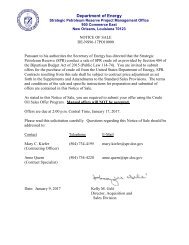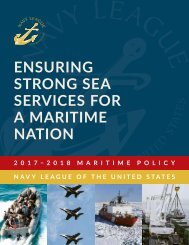2010-11_ANNUAL_REPORTS_-_FINAL_VERSION_(3)
2010-11_ANNUAL_REPORTS_-_FINAL_VERSION_(3)
2010-11_ANNUAL_REPORTS_-_FINAL_VERSION_(3)
Create successful ePaper yourself
Turn your PDF publications into a flip-book with our unique Google optimized e-Paper software.
Haiti on January 12, <strong>2010</strong>. MARAD began monitoring conditions and events that day in support of<br />
Operation Unified Response. On April 29, <strong>2010</strong>, MARAD again activated the MCC to support the<br />
response to the Deepwater Horizon oil spill. Personnel from MARAD monitored events continuously<br />
through September 6, <strong>2010</strong>, providing daily situation reports to senior leadership.<br />
On March <strong>11</strong>, 20<strong>11</strong>, MCC watchstanders monitored the situation when the 9.0-magnitude earthquake<br />
struck off Japan. All available vessels were put on stand-by, ready to assist. In August 20<strong>11</strong>, Hurricane<br />
Irene struck the East Coast of the United States creating devastation moving north. The MCC acted as a<br />
bridge for data inputs and issued situational briefs that were used by senior leadership and the White<br />
House. Five watch members received the Secretary of Transportation’s Outstanding Achievement Gold<br />
Medal award for assistance during Hurricane Irene.<br />
Missile Defense Agency Ships<br />
Two converted RRF ships, Pacific Collector and Pacific Tracker, are funded by the DOD Missile<br />
Defense Agency (MDA) via interagency agreement. In fiscal year 20<strong>11</strong>, they were activated four<br />
times to track missile and high altitude aircraft flights. The vessels remained on-station with no<br />
difficulties. While the vessels are owned by DOT/MARAD as part of the NDRF, all costs for<br />
maintenance, repair, operation, and management oversight are reimbursed by the Missile Defense<br />
Agency.<br />
The director of MDA’s Test Resources Directorate, David W. Furtwengler, particularly commended the<br />
Pacific Collector crew, and reminded them that without their “efforts the data that is vital in the<br />
development of an effective missile defense system could not have been collected. The high standards<br />
of seamanship demonstrated while maneuvering your vessel and in navigating the Pacific Collector<br />
during this important mission have contributed to the Nation's security and MDA's ability to make<br />
missile defense a reality.”<br />
National Defense Reserve Fleet (NDRF) Anchorages<br />
Ship Disposal<br />
The Maritime Administration is committed to disposing of obsolete vessels in its National Defense<br />
Reserve Fleet (NDRF) anchorages. In <strong>2010</strong>, the inventory of ships shrank from 196 to 185 vessels, with<br />
the fleet anchorage inventory reduced from 129 to 123 ships, 7 due primarily to SBRF disposal<br />
departures. At year’s end, 31 vessels were maintained in a retention status for emergency sealift, interim<br />
hold, fleet support, and logistic support because the ships were needed for those purposes. The Fleet<br />
anchorages also maintained 26 vessels in a custody status for other government organizations such as<br />
the Army, Navy, National Oceanic and Atmospheric Administration (NOAA), and the U.S. Coast Guard<br />
(USCG). The disposal actions, combined with appropriate ship maintenance practices, have helped<br />
reduce the number of vessels considered to be in poor condition from 23 to 13, and have increased the<br />
average vessel condition (3.66 to 3.82 on a 5-point scale).<br />
During 20<strong>11</strong>, the inventory of ships further shrank to 163 vessels, with the fleet anchorage inventory<br />
reduced to 101 ships, again due primarily to vessel disposals. At year’s end, 35 vessels were maintained<br />
in a retention status for emergency sealift, interim hold, fleet support, and logistic support. The Fleet<br />
anchorages also maintain 21 vessels in a custody status for other government organizations such as the<br />
7 The NDRF inventory includes all MARAD-owned vessels: retention/non-retention vessels at anchor in NDRF<br />
anchorages, RRF vessels berthed at various ports, and school ships on loan to the State Maritime Academies. The<br />
fleet anchorage inventory includes only NDRF ships at the anchorages, plus vessels belonging to other government<br />
organizations, but maintained at NDRF anchorages.<br />
26




